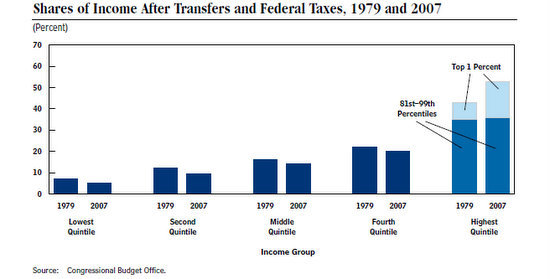The Congressional Budget Office has officially confirmed what we already knew: The income distribution has been getting more unequal in recent decades. A new report (PDF) on changes in the distribution of income from 1979 to 2007 shows that average income for the top 1 percent "grew by 275 percent between 1979 and 2007." In the same time period, the rest of the top 20 percent saw their average income grow by 65 percent. Those in the middle—60 percent of Americans—had average income growth of just under 40 percent. And, of course, the 20 percent with the lowest income saw the smallest income growth between 1979 and 2007, at just 18 percent.Government policy increased the tilt toward the very richest:“The equalizing effect of federal taxes was smaller” in 2007 than in 1979, as “the composition of federal revenues shifted away from progressive income taxes to less-progressive payroll taxes,” the budget office said.Also, it said, federal benefit payments are doing less to even out the distribution of income, as a growing share of benefits, like Social Security, goes to older Americans, regardless of their income.The end result is that, as the graph above shows, after transfers (like Social Security) and taxes, the richest 20 percent were taking in 53 percent of the income in 2007, up from 43 percent in 1979. The increase was even greater for the top 1 percent, whose share of income more than doubled in those years, from just under 8 percent to 17 percent. By contrast, of course, the 20 percent of people making the least money saw their share of after-tax income drop from 7 percent in 1979 to 5 percent in 2007. The broad middle class, too, lost ground on its share of after-tax income.All of which is just as congressional Republicans want. They're just looking to finish the job.
"A child's learning is the function more of the characteristics of his classmates than those of the teacher." James Coleman, 1972
Wednesday, October 26, 2011
The 1% Get a 275% Raise
Subscribe to:
Post Comments (Atom)

No comments:
Post a Comment